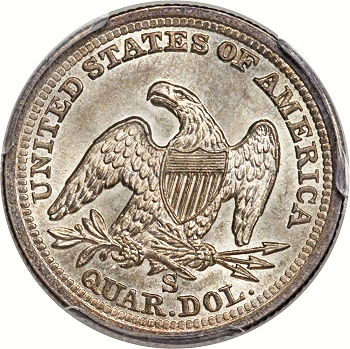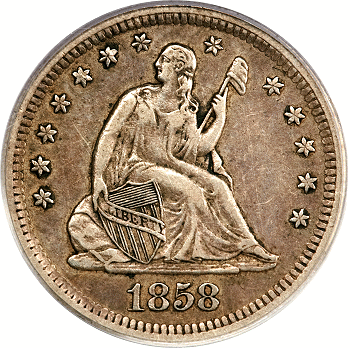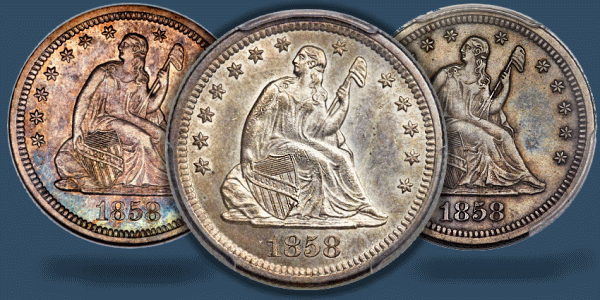Coin Rarities & Related Topics: News and Analysis regarding scarce coins, coin markets, and the coin collecting community #302
A Weekly CoinWeek Column by Greg Reynolds ……
The only known uncirculated 1858-S quarter is ‘in the news’; the Richmond-Gardner coin will be offered by Heritage tomorrow night, October 29th, in New York, at the Waldorf Astoria Hotel. Generally, 1858-S quarters are extreme condition rarities in grades above the Very Fine range, especially in grades above EF-40. The Richmond-Gardner piece is PCGS graded MS-62 and CAC approved. Another Gardner 1858-S, which was formerly in the Eliasberg Collection, is surely one of the top five known and will be sold tonight. The Eliasberg-Gardner 1858-S is NGC graded as AU-58.
Though very rare in all grades, the 1858-S does not receive much attention. Few collectors realize that maybe just twenty grade above EF-40. It seems that the 1858-S quarter has been largely forgotten.
Although the Richmond-Gardner 1858-S was recently in the collection of Gene Gardner, it is not in the fourth sale of the Gardner Collection, which is being held today at the Waldorf Astoria Hotel. The Richmond-Gardner 1858-S was sold in the third Gardner sale on May 15, 2015, and is re-appearing this week for undisclosed reasons. The Eliasberg-Gardner 1858-S, which is NGC graded AU-58, is being offered for the first time in more than fifteen years.
Gene Gardner formed the all-time greatest collection of Liberty Seated coins overall, the all-time greatest set of Barber quarters of which I am aware, and very important sets of many other series of U.S. coins. The first Gardner auction was on June 23, 2014, and the second occurred one year ago, on October 27, 2014. (Please click on words in blue to access reviews of past auctions and other references.)
As already mentioned, the third Gardner sale was held on May 15, 2015. The fourth will close an era, as Gene Gardner has been a major presence in the coin collecting community for twenty years and he was involved at a high level during an earlier era of his life. Stack’s (NY) auctioned his first collection in 1965!
It is indisputable that Gene’s set of Liberty Seated quarters is vastly superior to any other such set. I will cover his Barber quarters in the future. Gardner had many excellent bust quarters and Standing Liberty quarters as well.
There are fourteen design types of classic silver quarters: 1) Draped Bust, Small Eagle (1796 only); 2) Draped Bust, Heraldic Eagle (1804-07); 3) Reich Capped Bust, “Large” (1815-28); 4) Kneass Capped Bust, “Small” (1831-38); 5) Liberty Seated, No Drapery, No Motto (1838-40); 6) Liberty Seated, With Drapery, No Motto (1840-53 and 1856-65); 7) Liberty Seated, Arrows & Rays (1853 only); 8) Liberty Seated, Arrows, No Motto, No Rays (1854-55); 9) Liberty Seated, Motto (1866-73 and 1875-91); 10) Liberty Seated, Arrows, Motto (1873-74); 11) Barber (1892-1916); 12) Standing Liberty, Open Chest (1916-17); 13) Standing Liberty, Covered Chest (1917-30); 14) Washington (1932 on).
Later silver issues of various subtypes of Washington quarters are not classic U.S. coins. These are popular and require separate discussions.
There are multiple rarities within the ‘No Motto’ type (#6 above), though 1858-S quarters are among the rarest. A coin is very rare if fewer than 250 are known in all states of preservation, including representatives of all die varieties of the issue.
There could not be more than 235 1858-S quarters in existence, maybe not even 165! PCGS has graded around eighty and NGC has graded thirty-eight. These totals probably amount to fewer than 100 different coins. There are at least another fifty and maybe another ninety that are either non-gradable or have not been sent to PCGS or NGC during the last fifteen years, if ever. There are many collectors who seek non-certified coins that grade from AG-03 to Fine-15.
Surprisingly, data reported by PCGS and NGC for the 1858-S seems consistent with that for the 1849-O, which is acknowledged as being a key. I covered the 1849-O in July 2014. I then estimated that there exist 120 to 160 1849-O quarters, probably not more than 145. A larger number of non-certified 1858-S quarters survive.
Certification data does not reveal that, in AG-03 to VG-08 grades, there are more 1858-S quarters around than 1849-O quarters. In total, there are probably between 165 and 200 1858-S quarters, perhaps 180. It is interesting to consider the relative commonality of key date Morgan silver dollars and of keys to most series of 20th century coins. From a logical perspective, rarities in series of Liberty Seated coins may be sound values.
Among San Francisco Mint, ‘No Motto’ Liberty Seated quarters, the 1859-S is much more famous than the 1858-S. Curiously, an uncirculated 1859-S is not known to exist. Even so, the 1859-S is probably only slightly rarer overall than the 1858-S.
When a certified AU-50 1859-S quarter appears in auction, there is much discussion about it at lot viewing sessions and in conversations among collectors around the nation. The 1860-S is rare and has commanded more attention as well. The 1860-S is probably rarer than the 1858-S, though not much rarer. The highest certified 1860-S was also in the Gene Gardner Collection
The NGC graded MS-61 1860-S, which was CAC approved, brought $55,812.50 in the Gardner II sale, on Oct. 27, 2014. It was especially attractive for a certified MS-61 quarter. The scratches near the date may have been among the reasons that it was not assigned a higher grade. It later crossed into a PCGS holder and did not sell in the Heritage CSNS auction in April 2015.
Although I have attended coin events since I was seven years old, including dozens of major auctions, I cannot remember anyone ever talking about an 1858-S quarter. I recollect multiple discussions relating to 1849-O, 1859-S and 1860-S quarters.
I had forgotten that just one uncirculated (‘mint state’) 1858-S is known, and I am certainly not be the only Liberty Seated coin enthusiast who did not remember that 1858-S quarters are very rare in all grades.
The Richmond-Gardner 1858-S Quarter
The Richmond-Gardner 1858-S was PCGS graded MS-62 before it was auctioned by Bowers & Merena (of New Hampshire) in 1995. It then realized $6600.

Most of the PCGS graded coins in the Richmond Collection were ‘crossed’ into NGC holders by David Lawrence Rare Coins before the three auctions of the Richmond Collection in July 2004, November 2004 and March 2005. I attended all three events.
Although the Richmond-Gardner 1858-S crossed from being NGC graded as MS-62, NGC continues to report an 1858-S as being graded MS-62. Is this an old listing for the Richmond-Gardner coin that was never deleted? Alternately, did a PCGS or NGC graded AU-58 1858-S become graded MS-62? Before an auction in October 2012, a Heritage cataloger pointed out that NGC reported having graded three 1858-S quarters as AU-58 in August 2012. NGC has since reported eleven! This total of eleven probably includes several re-submissions of the same coins.
A collector in the Midwest formed the Richmond Collection over a period of many years. It is probably one of the fifteen all-time greatest collections of classic U.S. coins, certainly it is in the top twenty-five. As far as I know, I am the only coin enthusiast who has ever written about the Richmond Collection.
 When it was auctioned on March 7, 2005, the Richmond 1858-S quarter was NGC certified, as was almost every coin in the Richmond III sale, with just a couple of exceptions. It is more important that it was graded as MS-62 prior to August 1995. It was thus graded before an era of grade-inflation and coin doctoring characterized the coin business from 1997 to 2006 or 2007, a topic which I touched upon last week. In 2014, this coin received a CAC sticker of approval while in an NGC holder.
When it was auctioned on March 7, 2005, the Richmond 1858-S quarter was NGC certified, as was almost every coin in the Richmond III sale, with just a couple of exceptions. It is more important that it was graded as MS-62 prior to August 1995. It was thus graded before an era of grade-inflation and coin doctoring characterized the coin business from 1997 to 2006 or 2007, a topic which I touched upon last week. In 2014, this coin received a CAC sticker of approval while in an NGC holder.
In my view, there is no doubt about the Richmond-Gardner 1858-S being strictly uncirculated. Moreover, the assigned 62 grade is probably not controversial at all. It is a lustrous and attractive coin. It was moderately dipped many years ago and his since naturally retoned to an extent, predominantly a blue-gray color. It has not received a higher grade assignment, mostly because of two very noticeable thin scratches. One is between Miss Liberty’s wrist and the tenth star. The other is to left of the numeral ‘1’ of the year 1858.
The reverse, by itself, qualifies for a 63 grade. Indeed, the reverse has neat cartwheel luster.
On March 7, 2005, at a hotel in Baltimore, this coin realized $44,850. On May 15, 2015, at the Waldorf, this same coin brought less, $35,250. A sophisticated collector from the New York area was willing to pay at least $23,000, maybe much more. Ultimately, this coin ‘went to the book,’ which means it was purchased by an absent bidder who left a bid prior to the sale of this lot.
On Oct. 25th, it was clear on the Heritage site that the ‘reserve amount’ was “$24,000.” The Richmond-Gardner 1858-S is certainly worth that much. Undoubtedly, it is more appealing than many other Liberty Seated coins that are PCGS or NGC graded as MS-62.
Generally, 1858-S quarters are nearly as expensive. In March 2014, Stack’s-Bowers sold a PCGS graded AG-03 1858-S for $170.38.
Second Gardner 1858-S Quarter
Until title passes, Gene Gardner will have another 1858-S quarter in his collection. This afternoon, the Eliasberg-Gardner 1858-S will be auctioned. It is NGC graded as AU-58.
Louis Eliasberg, Sr. formed the all-time greatest collection of classic U.S. coins. This 1858-S quarter was cataloged as “AU-58” in 1997. Although Charlie Browne then graded it as “AU-55,” the level of friction on this coin does seem now to be consistent with an AU-58 grade, in accordance with current standards. On April 6, 1997, it brought $3300, a strong price and a substantial sum at the time.
 Evidently, Gardner did not acquire this 1858-S at the Eliasberg ’97 sale by Bowers & Merena in New York, though he was in attendance. According to a Heritage cataloger, Gardner purchased the Eliasberg 1858-S from DLRC in 2000.
Evidently, Gardner did not acquire this 1858-S at the Eliasberg ’97 sale by Bowers & Merena in New York, though he was in attendance. According to a Heritage cataloger, Gardner purchased the Eliasberg 1858-S from DLRC in 2000.
Although the Eliasberg-Gardner 1858-S quarter has a few technical issues and some friction, some coin collectors might prefer it to the just discussed Richmond-Gardner coin. The Eliasberg-Gardner 1858-S has plenty of appealing natural toning and an original overall appearance. It has probably never been dipped.
Miss Liberty is tinted a neat russet color. The obverse fields are characterized mostly by a blend of gray, cloudy blue and russet. There are some neat blue-green tones about the numerals of the ‘date’ and in the lower fields.
The eagle on the reverse possesses some pleasing ‘mint frost.’ Most of the design elements are russet and the reverse fields tend to be a bluish-gray color. When this coin is tilted under a lamp, however, much of the reverse fields turns a cool orange color.
There are many contact marks and hairlines in the fields on both sides. A group of marks near Miss Liberty’s left arm, at the viewer’s right, is a little bothersome. These marks, however, are not large. Moreover, the contact marks and the hairlines on this coin seem to be mostly covered by layers of toning, which may have formed naturally over a period of more than 150 years. On this coin especially, it is hard to gauge the quantity and magnitude of the contact marks and hairlines beneath the toning. Even so, this coin is particularly attractive for a coin that is certified as graded AU-58. I enjoyed viewing it.
 Heritage auctioned a different NGC graded AU-58 1858-S in October 2012, for $5581.25. I did not see it. That same NGC graded AU-58 1858-S crossed into a PCGS holder, with the same grade, and was auctioned by Heritage for $11,162.50 in March 2014 [See photo on right]. It did not stay at one location for long. In July 2014, it was offered at the Summer FUN auction in Orlando, where it did not sell. In November 2014, while in a PCGS holder with the same serial number that it had in March 2014, it was auctioned again, that time for $7050.
Heritage auctioned a different NGC graded AU-58 1858-S in October 2012, for $5581.25. I did not see it. That same NGC graded AU-58 1858-S crossed into a PCGS holder, with the same grade, and was auctioned by Heritage for $11,162.50 in March 2014 [See photo on right]. It did not stay at one location for long. In July 2014, it was offered at the Summer FUN auction in Orlando, where it did not sell. In November 2014, while in a PCGS holder with the same serial number that it had in March 2014, it was auctioned again, that time for $7050.
Condition Rarity
Perhaps twenty 1858-S quarters truly grade above EF-40. During the last five years, PCGS graded EF-40 1858-S quarters tended to sell for prices between $2500 and $3500 at auction, usually for around $3000. In July 2014, an NGC graded EF-40 1858-S sold for $2135.
In February 2014, an NGC graded AU-53 1858-S sold for $4406.25. In December 2014, Heritage auctioned a PCGS graded AU-53 1858-S for $4112.50. These auction prices are meant to provide a general idea as to the values for these and should not be taken too seriously. Even if two coins have been assigned the same numerical grade, surface quality and eye appeal may be dramatically different. Also, there are many factors that affect auction results.
To understand a coin and its value, there is a need to analyze the physical characteristics of the coin and to learn about the buyers or prospective buyers. Would a collector who is building an EF to AU grade set of Liberty Seated quarters be willing to pay more then some of these cited prices for an 1858-S that he personally likes and feels would fit into his set? Some rare Liberty Seated coins have been bouncing around among dealers, sometimes via auctions, over the last few years.
 Market levels for most U.S. rarities have not changed much from 2010 to the present. This is a positive sign in regard to demand for Liberty Seated coins. As Gene Gardner collected Proofs and business strikes of all denominations of Liberty Seated coins, and amassed a large number of duplicates, the first three auctions of his collection added a considerable supply of Liberty Seated coins to the marketplace and the auctions went well. Evidently, there are buyers who are willing and able to absorb them.
Market levels for most U.S. rarities have not changed much from 2010 to the present. This is a positive sign in regard to demand for Liberty Seated coins. As Gene Gardner collected Proofs and business strikes of all denominations of Liberty Seated coins, and amassed a large number of duplicates, the first three auctions of his collection added a considerable supply of Liberty Seated coins to the marketplace and the auctions went well. Evidently, there are buyers who are willing and able to absorb them.
While some of these buyers are dealers who are placing Liberty Seated coins in inventory, those dealer-buyers must have figured that demand for Liberty Seated coins will continue to be substantial in the near future. Collectors of Liberty Seated coins tend to proceed slowly with their respective pursuits.
There is much more demand from such collectors than most market participants thought there would be after the Gene Gardner, Greensboro, Scott Rudolph and “Joseph Thomas” collections were all offered since January 2009, each of which contained large numbers of Liberty Seated coins. When each of these collections ‘came on the market,’ more than a few market participants cried that there would not be serious buyers for the coins and markets would falter terribly. The reality is that, since 2010, there has been healthy collector-demand for Liberty Seated coins.
©2015 Greg Reynolds





